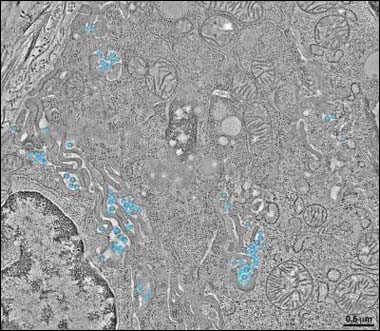3-D imaging offers detailed look at HIV-1 infection inside the gut
Three-dimensional electron microscopy imaging of an active HIV-1 infection in gut-associated lymphoid tissues revealed key differences between cultured cell and tissue infection models of the disease, according to results of a recent study.
The study researchers utilized 3-D electron microscopy to view an active HIV-1 infection in the gastrointestinal tract of mice with humanized immune systems. This enabled them to create a relevant model of the interaction between the virus and host immune cells. In this model of infection, the researchers observed the depletion of the humanized T cells in the gut-associated lymphoid tissue (GALT) of the mice and detected discrete HIV-1 particles as they sprouted from host cells and pooled in areas between cells.
The investigators charted HIV-1 to different gut cell types and substructures, and free virions were found to assemble in areas between cells. The virions also used areas of cell-to-cell contact called virological synapses to infect nearby cells. Most of the HIV-1 infected cells were contained within intestinal recesses, whereas fewer infected cells were seen in the mucosal regions or the lamina propria.

Figure 1. Pools of mature HIV-1 virions are populating the intercellular spaces highlighted by segmentation (blue: viral envelope; magenta: conical cores).
Source: Ladinsky et al.
Contrary to descriptions of HIV-1 virions extracted from infected culture cells as entirely mature, the tissue model revealed pools of both immature and mature free virions in the infected tissue. Moreover, there was a paucity of abnormally formed viral particles observed during the active infection.
“Our 3-D ultrastructural characterization of HIV-1–infected GALT identified dense regions of virus transmission, provided insights into the temporal nature of virus maturation, revealed HIV-1 transmission occurring by both free virus and direct cell-to-cell mechanisms, and demonstrated important differences between cultured cell and tissue HIV-1 infection models,” the researchers wrote. “The high resolution of our positively and negatively stained tissue samples allowed 3-D visualization of HIV-1 transmission within lymphoid tissue, providing a new approach for understanding HIV-1 infection in vivo.”
Disclosure: The researchers report no relevant financial disclosures.
